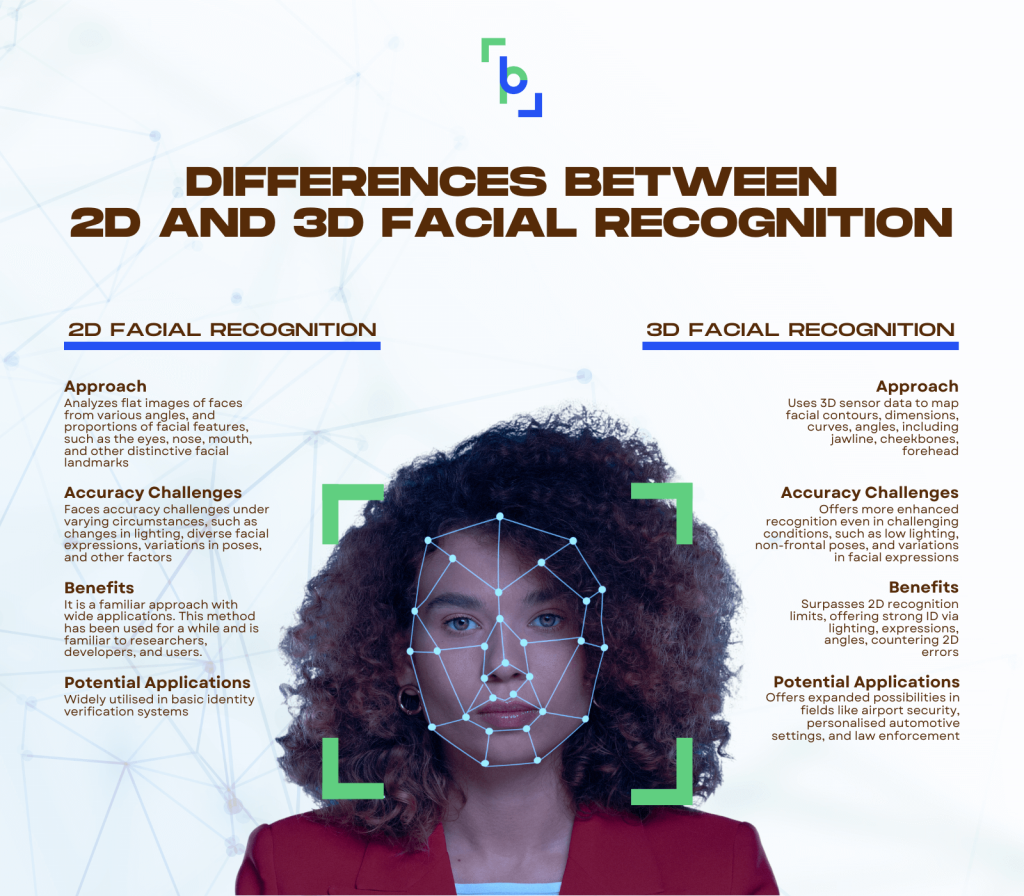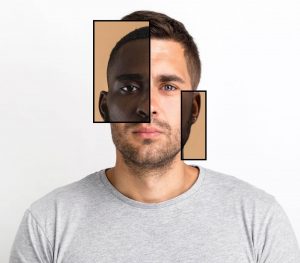In the landscape of biometric technology, the shift from traditional 2D facial recognition to 3D has sparked curiosity and innovation. Imagine a world where your face isn’t just a flat image, but a three-dimensional map of your face’s unique contours and features. This type of AI recognition technology is already being used to streamline many daily processes, from unlocking your phone to airport check, to helping police identify possible suspects.
However, at the same time, facial recognition technology has brought along concerns about possible racial bias and privacy risks.
Facial Recognition Statistics
- As per the evaluation of an ongoing pilot initiative at 25 US airports, TSA’s facial recognition algorithms are 97% accurate when implemented to 60,000 travelers, encompassing various demographics, including individuals with darker skin tones. (TSA)
- 73% of travelers are open to sharing their biometric information to enhance airport procedures for the purpose of spending less time in queuing. (IATA’s 2021 Global Passenger Survey)
- A total of 90% of travelers want their airport processes to take less than an hour when they have a checked bag while traveling. (IATA’s 2021 Global Passenger Survey)
- The Transportation Security Administration (TSA) plans to extend its facial recognition program to approximately 430 airports across the United States in the coming years.
- About 36% of travelers have encountered the use of biometric data during their journeys. 86% of them expressed satisfaction with the experience. (IATA’s 2021 Global Passenger Survey)
Quick Recap of the Differences Between 2D and 3D Facial Recognition
| 2D Facial Recognition | 3D Facial Recognition | |
|---|---|---|
| Approach | Analyzes flat images of faces from various angles, and proportions of facial features, such as the eyes, nose, mouth, and other distinctive facial landmarks. | Utilizes depth information from 3D sensors to provide an accurate representation of facial contours and dimensions, such as the unique curves, shapes, and angles that make up a person’s face, including features like the jawline, cheekbones, and forehead. |
| Accuracy Challenges | Faces accuracy challenges under varying circumstances, such as changes in lighting, diverse facial expressions, variations in poses, and other factors. | Offers more enhanced recognition even in challenging conditions, such as low lighting, non-frontal poses, and variations in facial expressions. |
| Benefits | It is a familiar approach with wide applications. This method has been used for a while and is familiar to researchers, developers, and users. | Overcomes limitations of 2D recognition, providing robust identification, by considering factors like lighting changes, facial expressions, and various angles that often lead to errors in 2D recognition |
| Potential Applications | Widely utilised in basic identity verification systems. | Offers expanded possibilities in fields like airport security, personalised automotive settings, and law enforcement, where enhanced accuracy is essential. |

Is 3D Facial Recognition Really More Accurate Than 2D?
Yes, 3D facial recognition technology demonstrates a significant advantage in accuracy over its 2D counterpart. This advantage results from the heightened depth information captured by 3D sensors, which enables a more precise rendering of facial contours and dimensions. Unlike 2D recognition, which relies on analysing flat images from various angles, 3D recognition uses the richer visual data from three-dimensional scans. Research findings consistently support the notion that 3D facial recognition outperforms 2D recognition.
One study published in the HCIS Journal highlights how this technology inherits the strengths of traditional 2D recognition, harnessing its innate familiarity and wide-ranging applications. However, what truly sets 3D systems apart is their remarkable accuracy even in challenging scenarios like low light conditions and an array of facial expressions and angles—situations that can often confound 2D systems.
Meanwhile, another insightful study by Vision Research delves into a face-matching task, putting 3D facial recognition to the test against its 2D counterpart. Faces were recognised with heightened precision in 3D imagery, demonstrating the added depth cues that amplify holistic processing—a vital ingredient for accurate facial recognition.
Both studies harmoniously converge to underscore the resilience of 3D facial recognition in conquering challenges that have long vexed 2D systems. This convergence paints a vivid picture of a technology ready to reshape the landscape of biometric identification. With the power to elevate accuracy and operational effectiveness, 3D facial recognition stands on the cusp of a new era—one that promises to transform how we identify individuals with unprecedented precision and efficiency.
Real-World Applications of 3D Facial Recognition Technology
3D facial recognition technology is already used in real-world scenarios to enhance security and convenience. According to a survey by CyberLink, over 131 million Americans use facial recognition ID every day, mostly for mobile phone applications, at airports, banks and medical offices. Authentication processes are expected to be employed much more in the future.

Some notable examples of where facial recognition technology is used include:
Airport Security
3D facial recognition at airports can be used to identify passengers at different checkpoints, from check-in and security to boarding gates, providing faster and more accurate identity verification, reducing queues and enhancing overall airport security.
In 2018, the Changi Airport in Singapore was the first to start using a 3D facial recognition system for seamless passenger processing. LAX followed suit in 2021 by introducing a new gate expansion, whose features include simply looking into a camera to be matched with data from the U.S. Customs and Border Protection’s Traveler Verification Service (TVS).
Through 3D facial recognition, travellers can go through immigration and boarding processes without presenting physical documents. The system captures and verifies passengers’ identities based on their unique facial features.
Passports and Visas
Some countries have integrated 3D facial recognition into passport and visa issuance processes. These systems enable border control agencies to match travellers’ faces accurately with the photos on their identification documents, improving identity verification and preventing identity fraud.
For example, the United Arab Emirates (UAE) uses 3D facial recognition technology for its Smart Gate system at Dubai International Airport. This system allows UAE citizens and residents to use 3D biometric data stored in their passports for quick and automated immigration procedures.
Mobile Devices
Some smartphones and tablets incorporate 3D facial recognition as a biometric authentication method. This technology allows users to unlock their devices, make secure payments, and access sensitive apps or information using their unique facial features.
For example, Apple’s Face ID technology on the iPhone X and later models employs 3D facial recognition to unlock the device and authorise secure transactions using Apple Pay.
Automatic Driving
The automotive industry is exploring the use of 3D facial recognition for vehicle security and driver identification. This technology can help prevent unauthorised access to vehicles and customise vehicle settings based on the recognised driver.
Ford’s Mach-E electric vehicle incorporates 3D facial recognition for driver identification and personalised settings. The car adjusts seat positions, mirrors, and entertainment preferences based on the recognised driver’s profile. Additionally, Omron Automation has introduced 3D facial recognition technology that detects a drowsy or distracted driver, potentially impacting the safety of manual driving.
Public Safety
Law enforcement agencies in certain cities use 3D facial recognition to identify suspects in surveillance footage. For instance, the London Metropolitan Police utilised “Live Facial Recognition” technology to identify and apprehend criminals captured on camera.
Use of 3D Facial Recognition in Commerce
Other than the public sector, such as by government agencies, facial recognition may also be used in commerce. A report by the Government of Canada speculated that we can expect that in the future, 3D recognition can be used to match your face to online databases (e.g., social media profiles) to deliver even more targeted ads.
Potential Concerns of Biometric Recognition Technology
3D biometrics also brings concerns that demand attention. Two major areas of concern include racial and gender bias, which can perpetuate inequalities, especially when used by law enforcement, and privacy risks, raising questions about data protection and individual autonomy.
Racial and Gender Bias
There is a pressing concern about racial and ethnic bias in 3D facial recognition technology. An article published by the University of Calgary rejects the misconception that this type of technology is unbiased, highlighting that AI can actually replicate human biases, specifically regarding race.
Certain facial recognition technology boasts a 99% accuracy in recognising white male faces while, at the same time, manifesting a staggering 35% error rate when identifying faces of colour, particularly Black women. This alarming disparity can have dire consequences when used by the police, leading to wrongful arrests and detentions.
Disturbing cases in the U.S. underscore the gravity of the issue, where innocent individuals have suffered due to misidentification by facial recognition software. Similarly, the UK’s Metropolitan Police were heavily criticised after using 3D facial recognition precisely due to the associated risk of racial bias.

Privacy Risks
AI facial recognition technology presents a range of privacy risks that merit serious consideration. One key concern revolves around the vast amount of personal data collected and stored. This type of biometric information cannot be changed, like passwords, if compromised, which raises the stakes for data breaches and can potentially expose individuals to identity theft and fraud. Additionally, the widespread deployment of facial recognition systems in public spaces has raised the alarm for many about mass surveillance. Amid these concerns, movements like “ReclaimYourFace” are gaining traction, particularly in Europe. “ReclaimYourFace” is a European movement that brings people’s voices into the discussion around biometric data used to monitor the population.
This movement questions why these sensitive data are being used and raises the alarm about the impact on our freedoms in public spaces. The movement underscores the importance of involving the public in shaping policies that govern the use of facial recognition technology, emphasizing the need for a balance between technological advancement and individual rights.
Considering the associated risks, AI facial recognition technology must be regulated before becoming implemented for widespread use.
Are There Rules and Regulations Regarding AI Facial Recognition Technology?
The rules and regulations regarding 3D facial recognition vary across different countries and regions. For example:
- United States – In the U.S., the regulatory landscape varies by state. Some states have introduced legislation that regulates the use of biometric data, including facial recognition. For instance, Illinois has the Biometric Information Privacy Act (BIPA), which requires organisations to obtain informed consent before collecting and using biometric data such as facial recognition.
- Canada – The Personal Information Protection and Electronic Documents Act (PIPEDA) governs the collection, use, and disclosure of personal information, including biometric data. Organisations must obtain explicit consent and provide individuals with clear information about how their data will be used.
- European Union (EU) – The General Data Protection Regulation (GDPR) applies to the processing of biometric data, including facial recognition. It requires organisations to inform individuals about the purpose and scope of data collection, along with providing the option to opt-out. In the Artificial Intelligence Act draft in April 2021, the European Commission proposed restricting the public use of facial recognition technology.
- China – China has been at the forefront of implementing facial recognition technology. While there are no specific regulations focused solely on 3D facial recognition, data privacy and security regulations apply. The Cybersecurity Law of China and other relevant guidelines emphasise data protection and user consent.
- Australia – The Privacy Act 1988 covers handling personal information, including biometric data. The Office of the Australian Information Commissioner (OAIC) provides guidelines on best practices for collecting and managing biometric information.
- United Kingdom – In the UK, the Data Protection Act 2018 and the GDPR govern the use of biometric data, including 3D facial recognition. Organisations must ensure transparency, accountability, and lawful processing of data.
It’s important to remember that as AI racial recognition evolves in the future, the regulatory landscape will evolve with it. This means that new regulations may emerge as the technology matures.
Striking the Balance
The shift from traditional 2D facial recognition to 3D has sparked curiosity and innovation. While this type of AI recognition technology is already being used to streamline many daily processes, this advancement doesn’t come without challenges.
3D facial recognition offers heightened accuracy and performance in challenging conditions but raises concerns about possible racial bias and privacy risks. So, addressing these concerns will be crucial to ensuring the responsible and ethical deployment of this technology.
As 3D facial recognition will undoubtedly continue to evolve, the balance between its immense potential and the need for safeguards against biases and privacy violations will be essential. It will allow us to harness the full benefits of 3D facial recognition while ensuring that it is a tool for progress rather than a source of controversy. This calls for a collaboration between technological innovation and strict regulations to pave the way for a more accurate and secure future of biometric identification
